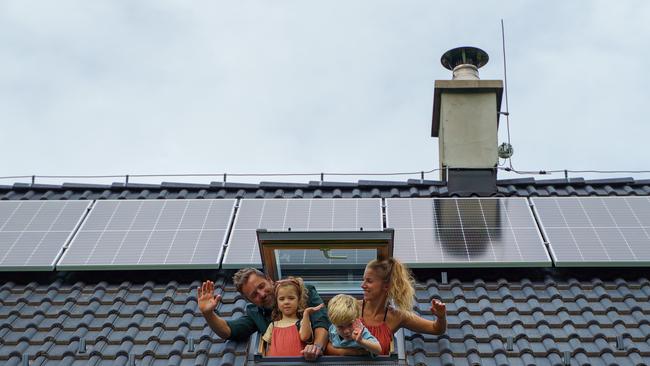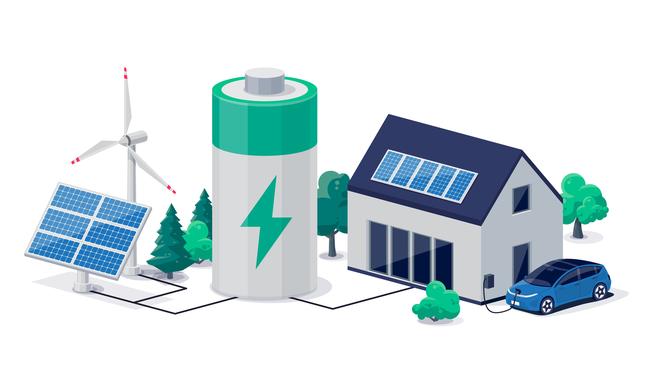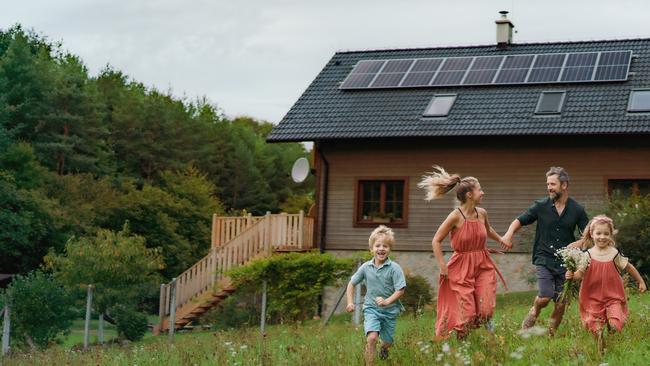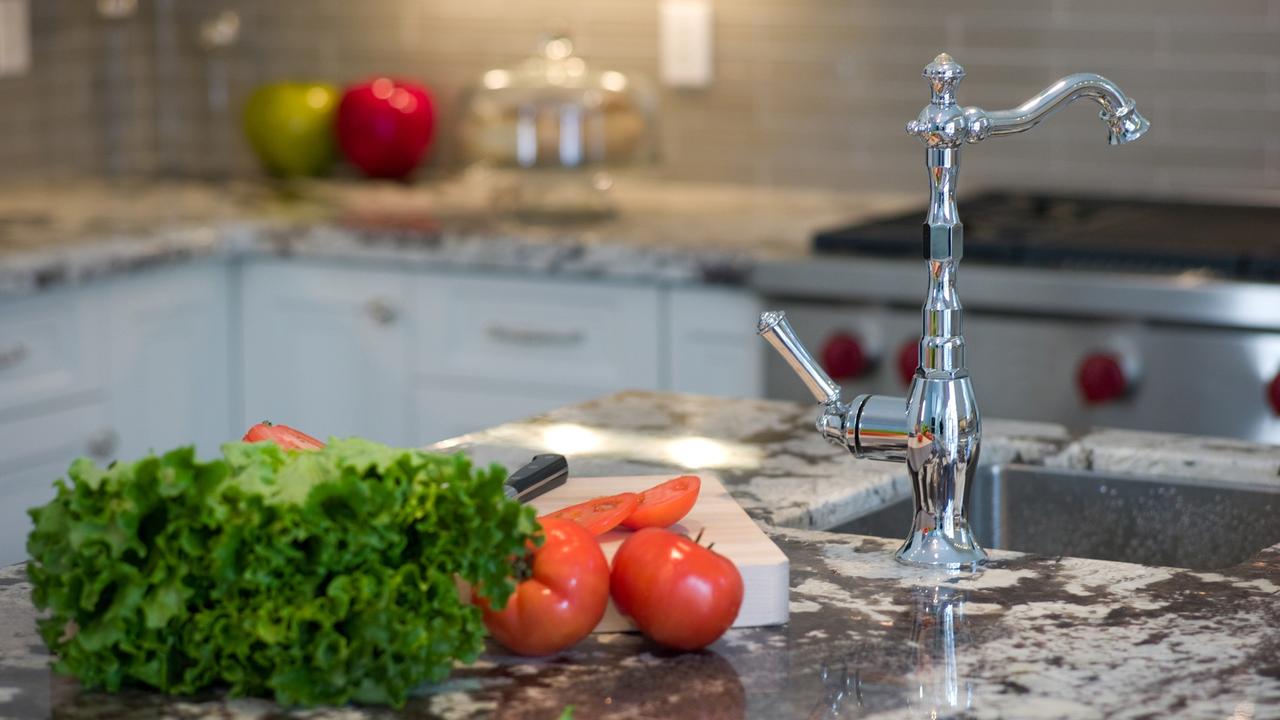Solar power – how to make sure you don’t get ripped off
Why it’s high time to look to the sun to save on household running costs and to care for our environment, experts explain how to avoid getting ripped off.

Home
Don't miss out on the headlines from Home. Followed categories will be added to My News.
With ever-increasing electricity costs, it’s not surprising that more Australians are considering a switch to solar energy. At least one in four Aussie homes now have rooftop solar panels – giving us the highest uptake of solar in the world. In fact, we now have a virtual power station of 17 gigawatts of solar across more than three million rooftops. And why wouldn’t we? Not only does solar provide immediate relief from soaring home power bills, there’s also the undeniable benefits to the environment through reducing our reliance on non-renewable forms of energy, such as coal.
But working your way through the myriad of information on solar energy can be tricky. How much money can you really save by going solar? And what happens when it’s a cloudy day? Here, we present answers to common questions to help you make an informed choice.

How much money can I save?
According to Solar Victoria, typical households can save up to $1073 a year on electricity bills when they install solar panels. Brisbane Sustainability Agency chief executive Tracy Melenewycz says the increasing price of fossil fuel-based energy means changing to solar power now will likely save you even more in the future.
“Switching to renewable energy, such as solar power, is a fantastic way for residents to lower their electricity bills and household carbon emissions,’’ she says.
“As the price of fossil fuel-based energy continues to rise, the savings that households can make on their electricity bills from installing solar power continues to grow. It’s a win for homeowners’ budgets and the environment.’’
Clean Energy Council distributed energy director Darren Gladman says you should see a return on investment from solar installation within five years.
“Putting solar on your roof is a very shrewd investment,’’ Darren says. “It reduces your electricity bill and, depending on where you live and how you use electricity, a well-designed solar system should pay for itself in five years or thereabouts.
“That’s an outstanding rate of return for such a safe investment.’’

What rebates are available and how to access them?
To encourage more people to make the switch to solar, there are various rebates and incentives to help make the initial outlay more affordable. For example, Victoria offers solar panel rebate of up to $1400 to eligible households, while in NSW, low-income earners may qualify for a free 3kWh solar energy system. To find out what you may be eligible for, go to www.energy.gov.au/rebates. “The Clean Energy Council recommends asking your approved solar retailer whether you are eligible for further incentives or seek additional information from your state or local government,’’ says Darren. “When you receive a quote for a solar or battery storage system, the retailer will show any rebate amount you are receiving.’’
There are also a variety of solar feed-in tariffs, where households are paid for each kilowatt hour of unused electricity generated by their solar system that is exported into the electricity grid. While it won’t make you rich, the tariffs will help to reduce your power bills even further.

How many batteries?
Home batteries can be quite expensive and have long pay-back periods. While you don’t need to have a battery connected to your solar panels, Origin future energy head of growth Michael Artup says if you can afford it, having a battery will further reduce your electricity bills.
“The great thing about batteries is they can store some of the solar generated energy you don’t use during the day to power your home at night when the sun isn’t shining – and, in the process, reduce the amount of energy you need to buy from the grid in the evening,’’ Michael says. “When considering a battery to go with your home solar system, the most important thing is to consider when and how you use energy so you get a battery that is the right size for your energy needs. This includes considering how much electricity you use, when you use it and how much excess solar is generated.’’

Should I get more batteries or solar panels?
The number of solar panels you can have will ultimately be determined by the size of your roof but United Solar Group chief executive Richard Vargas says the more panels you have, the more energy you can capture to power your home.
Richard says batteries come into their own in situations such as a power blackout, where the stored energy can maintain critical appliances such as fridges, freezers and lights. The bigger the battery storage capacity, the more power you will have.
“Solar batteries can make a difference, depending on the amount of energy you need for your home,’’ he says. “But you will need enough solar panels to feed energy into the battery so, for most homes, having more solar panels coupled with a solar battery that is sized to your energy needs will make (the biggest) difference.’’
How long do solar panels and batteries last?
Solargain national sales manager Mark Stevens says quality solar panels should last at least 25 years, while top brands come with a 40-year warranty.
“However, not all solar panels are good quality and fail well before their warranty period,’’ Mark says. “Unfortunately for some, claiming that warranty can be virtually impossible if the manufacturer doesn’t have an Australian subsidiary or if the solar retailer is no longer in business.’’
For this reason, Mark recommends choosing quality panels with an established Australian presence and also using an established, reputable solar panel installer.
Batteries usually carry a 10-year warranty and should retain 70 per cent of their original storage capacity in their tenth year.
“To extend the lifetime of your system, we recommend annual checks and servicing on your system,’’ Mark says.

Can I run my whole home on solar?
Given the sun provides enough sunlight in an hour to power the world’s energy needs for a year, it is entirely feasible to power your whole home using solar, says United Solar Group’s Richard. Understanding when you consume energy goes a long way towards successfully transitioning to exclusive solar power. Richard says you may need to change when you use your appliances so that they operate during sunlight hours.
“Many homes consume a larger volume of their weekly power needs during the weekends,’’ Richard says.
“High energy consumption appliances such as washing machines, vacuum cleaners, dishwashers, electric heaters and coolers and pool pumps can all be used during daytime hours (and) this will enable appliances to be powered by solar thus displacing the need to buy power from your power company.
“For homes that still have a heavy consumption outside daylight hours, you can now install a solar battery that can complement your solar panels. These batteries can easily store all your daytime energy production to power your entire home, as long as you have a roof space to install solar panels to cover your entire day’s energy needs.’’
What happens on a cloudy day?
Origin’s Michael says solar panels can still work on cloudy days but the power generation is usually less than what it could be on a sunny day.
“The thickness and density of the clouds and how consistent the weather is all affect how much energy the solar panels will produce,’’ Michael says. “Overall though, Australia has the highest solar radiation per square metre of any continent in the world, receiving an average of 58 million PJ (petajoules) of solar radiation per year, approximately 10,000 times larger than its total energy consumption.’’
What about solar hot water?
If you are looking for other ways to go off-grid, you may also want to consider solar hot water systems. Although if you don’t have enough roof space to fit solar panels for electricity and hot water, Solargain’s Mark recommends you consider a heat pump instead. Heat pumps use efficient heat exchanger technology, requiring about one-third of the energy of conventional electric or gas hot water systems.
“Combined with a solar (electricity) system, water heating costs are reduced even further by using free excess solar power to run the (heat pump) instead of grid power,’’ Mark says.
“By the time the family comes home in the afternoon, a 180L or270L tank of hot water is ready to enjoy, with boosting available if needed.
“Thanks to the efficiency of solar hot water and heat pumps, you can expect to reduce your water heating costs by up to $1000 per year. These technologies are also eligible for government incentives of around $1000 (that is) offered as an upfront discount by your solar company.’’
Solaray Energy director Jonathan Fisk says the rush to install home solar is leading to dodgy operators entering the market. He urges homeowners to find a reputable installer and get a second quote too. Also, make sure you understand what you are getting. Jonathan says some adverts still reference string inverters as smart solar, despite newer microinverters being far more efficient.
“Just because an inverter is Wi-Fi connected to an app does not make it a smart solar system, nor does it allow you to take control of your energy management the same way that Enphase microinverters do, for instance,’’ Jonathan says.
Be aware of cheap solar batteries too – while they may save you money in the short-term, without the right technology, software and management, they could easily need replacing.
And check installation quotes carefully to avoid hidden costs. Contracts should take into consideration your roof type, how many storeys your house is, access to the roof, split arrays across multiple roof sections, cathedral ceilings, tilt frames for panels on flat roofing, travel charges, full installation (including mounting of panels, inverter and cable runs) and a post-sale service check. Finally, just as home builders have gone bust in recent times, so too are solar installers. Jonathan recommends companies that install solar as their main business, have local technical support staff and a track record of a decade.
Originally published as Solar power – how to make sure you don’t get ripped off


